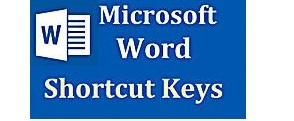The Top 10 Keyboard Shortcuts in Word and Excel that Help You Work Faster


You may think you know all the Word keyboard shortcuts you need, but check this list first: These 10 will help everyone work faster.
Shortcuts have evolved into an onscreen, menu-driven template with multiple options for each command in the program, also known as Ribbon shortcuts or access keys. But don’t worry, the original simultaneous and combination shortcut keys are still available and working great! Please note that in this article, the letter ‘F’ followed by a number (1 through 12) refers to the function keys.
Press the Alt key to access the Ribbon shortcuts. Commands (also called key tip badges) are displayed in black boxes. Click to view full image.
The 5 essentials for Word
No matter what you do, these shortcuts will serve you well.
1. Undo, Redo
Because we all make a lot of typos and errors while working, the first ones on this list have to be Undo and Redo: Ctrl+Z and Ctrl+Y. The Ribbon shortcuts are on the Quick Access Toolbar. Undo is depicted by an arrow curved to the left in Word.
Undo! There’s a ribbon shortcut for that and Redo, plus Find & Replace
2. Find & Replace
Corrections are a nightmare without Find (Ctrl+F) and Replace (Ctrl+H). Ribbon shortcuts are Alt+H-F-D-F for Home, Find, Find in Word.
Replace in Word is Alt+H-R for Home, Replace.
3.copy, cut and paste
You can copy and paste a paragraph using the original shortcut keys: Ctrl+C for copy (or Ctrl+X for Cut), and then Ctrl+V for paste.
The Ribbon shortcuts are Alt+H-C for Home, Copy (or Alt+H-C-C for Home, Copy, Copy in Excel) and Alt+H-X for Home, Cut in Word.
For Paste, it’s Alt+H-V-K for Home, Paste, Keep Source Formatting in Word
You can make faster work of Cut, Copy and Paste using the Ribbon shortcut keys. Click to view full image.
4. Select or Select All
Another shortcut that’s often used with Cut, Copy, Paste is Ctrl+A, which means Select All: That is, select the entire document, or file. On the Ribbon, it’s ALT+H-S-L-A (Home, Select, All).
But you don’t have to go wild. In Word, place your cursor on any word and click twice to highlight/select that word. Click three times to select the entire paragraph.
5. Print and Print Preview
Print is simple, but many users go straight to Print Preview as a final sanity check on margins and layout. For Print, it’s Ctrl+P or Ctrl+Shift-F12. Print Preview is Ctrl+F2. The Ribbon version is Alt+F-P for both File, Print and Print Preview, because when you select Print, the Preview displays as well.
You save constantly (or you should), which is why you’ll want to use these ribbon shortcuts for Save and Save As, plus Print and Print Preview. Click to view full image.
Navigation shortcuts
The bigger your document is, the harder it is to move within it. These keyboard shortcuts make it easier to get where you need to go.

6. GoTo
The only Navigation command on the Ribbon menu is the GoTo feature, which means go to a specific cell address (formula, object, region, etc.) or go to a specific page (section, line, graphic, etc.). It’s Ctrl+G or F5, followed by a dialog box that opens for additional input—the same dialog boxes as the Ribbon shortcuts. For the Ribbon commands, it’s Alt+H-F-D-G (Home, Find, GoTo).
The GoTo feature can take you to a specific cell address or specific page. Click to view full image.
7. Home
In Word, Home moves the cursor to the beginning of the line or row of your cursor’s current location. For example, if your cursor is on the ninth word of the third line, Home moves the cursor to the beginning of that line. Ctrl+Home moves the cursor to the Home position—that is, the beginning of the document.
In Excel, Home moves the cursor at the current cell address (e.g., K19) to the beginning of that line or row. It also moves the cursor to the beginning of a line or formula inside a cell while in Edit Mode. Ctrl+Home moves the cursor to cell A1.
8. Ctrl
In Word, Ctrl+Right Arrow moves the cursor across the document one word and/or punctuation mark at a time. Ctrl+Left Arrow does the same from right to left. Ctrl+Down Arrow moves the cursor down one carriage return/line break at a time. Ctrl+Up Arrow does the same from bottom to top. Ctrl+Page Down and Ctrl+Page Up move the cursor up and down one page at a time.

9. Shift
In Word, Shift+End highlights from the cursor position to the end of the line, and Shift+Home highlights to the beginning of the line. Shift+End+Down Arrow extends the highlight to the next line, and you can keep pressing Down Arrow to extend the highlight line by line. Shift+Home+Up Arrow does the same in reverse, going to the beginning of the line and up.
Shift+Page Up and Shift+Page Down move the cursor up and down one screen at a time (about one third of a page).
10. End
In Word, the End key moves the cursor to the end of a line. Ctrl+End moves the cursor to the end of a document, which includes any additional line or page breaks, tabs, spaces, etc.

Reference
JD Sartain (Oct 24, 2014 3:30 AM) PCWorld Retrieved from http://www.pcworld.com/article/2838010/the-top-10-keyboard-shortcuts-in-word-and-excel-that-help-you-work-faster.html

